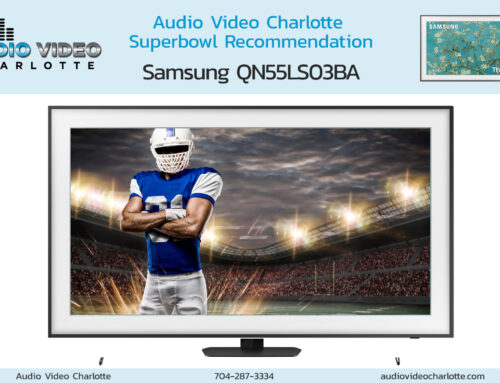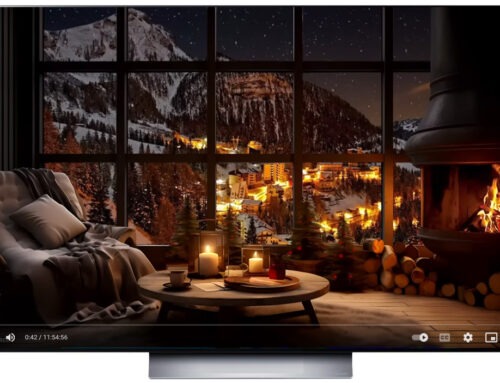What are the rules for taking care of your outdoor TV? Surely the presence of moisture and long periods of exposure to sunlight and wind and other wintery elements can negatively affect the integrity of the product. Taking care of your outdoor television is essential, and luckily the winterization process is neither difficult nor expensive.
These days, purchasing a new television is considered an investment in something that should produce for years after buying it. Since the modern TV is an entertainment hub—in the full sense of the word: it plays music, video, and acts as a computer—it’s important they are taken care of. The very idea of spending hundreds (even thousands) of dollars on one, only to keep it outside, is a bit frightening. But, worry not. You can have the pleasure of sitting outdoors, soaking up the sun while watching your favorite show with the peace of mind that your investment is safe from the elements.
At Audio Video Charlotte, we know our televisions, and we have everything you need to know about placing, weatherproofing, and caring for your outdoor TV.
Outdoor TVs Versus Indoor TVs
One question when it comes to televisions is, what’s the difference between an outdoor and an indoor TV? Can’t you just use an indoor TV outside? The quick answers to both questions are as follows: there is a big difference between outdoor and indoor TVs, and NO!, you should not use an indoor television outside.
Here are two reasons why you should pay the extra cost to get a TV specially made for your outdoor area:
- They have special screens that can be seen in exterior light. Because natural, exterior light is much brighter than indoor light the screens to outdoor televisions have to be brighter and a bit stronger than those built for indoors. Do keep in mind, however, that no TV should be positioned so the sun is directly facing it for long periods of time.
- All outdoor TVs are designed to withstand the elements. These TVs are waterproof and built to fight against pollen, as well as, extreme temperatures. With this in mind, it is still a good idea to weatherproof your outdoor television during those really hot and those really cold months of the year. You’ll be glad you went the extra step, as it will make your system last much longer.
Though it would be nice to save some money upfront and purchase a well-made indoor TV for your outdoor patio, you will actually end up losing money this way. To get your money’s worth, get what you need: a TV made specifically for the outdoors. With the right placement, and by caring for your television properly, you will be able to enjoy it year after year.
Where To Mount Your Outdoor TV
Adding an outdoor TV to your patio or deck or garage, etc., is a great way to elevate your outdoor entertainment areas. But where to place the television? In order to be sure you can perfectly see your television while you are grilling, swimming in the pool, relaxing on the deck, sitting by an outdoor fire pit, or playing a quick game of corn hole, there are a few things to consider before setting up that new TV.
First, consider the following questions: what is the size of your yard? What are your favorite outdoor activities? How accessible are your outdoor electrical outlets? The answers to these should directly inspire your desired locations—make sure you can see the television doing what you like while you are outside!
Next, depending on the access to an electrical outlet, try and find a spot that remains shaded for most of the day. It doesn’t have to be shaded all day, but look for an area that stays out of direct sunlight most of the day.
Now that you have your spot narrowed a bit, make sure you can seat a group of people in that area—at least enough space for your friends and family to enjoy a football game or a movie.
And that’s all it takes to find an outdoor spot for your new television. A bit of advice: even though you may have decided on a good spot, take a day to think about it, to walk by, or even sit in the space before mounting the TV. You never know, a better spot could reveal itself! The key is not to rush this part of the process, because once that TV is up, you are not going to want to move it.
How To Weatherproof Your Outdoor TV
When it comes to making sure your television is safe from exterior elements, there are two popular, and effective, ways to weatherproof: cover or cabinet.
Mounted and Covered
It is important to make sure your television, regardless if you choose to cover or use an enclosed cabinet, is properly mounted.
It’s best if you can keep your DVD player, cable box, etc. indoors. However, that is not always possible, which means you might need to invest in a cable box cover, which will keep these products from rusting and getting ruined by moisture—as they, unlike your television, are not made to sit outdoors.
Next, you need to get what’s called a Full TV Cover. This type of cover will protect the entire TV (front, back, mount, everything) from being harmed by extreme weather. Full Covers are great because they fit over all types of TVs and mounts, so you don’t have to worry about trying to match a cover to your TV.
What makes Full Covers so impactful is the fact they are made of strong water-resistant material that keeps rain and dirt from infiltrating your system. The interior of the cover contains a fleece lining, which protects the screen and other sensitive areas of the television. There is also a pouch in the back, which makes accessing cables and controls easy while the TV is covered.
Mounted in a Cabinet
If your outdoor TV is positioned in a spot that tends to receive rain or a lot of sun, it might be a good idea to go with a cabinet. Mounting your TV in a cabinet not only completely closes it off to the outside, it also keeps it safe from theft.
Using a cabinet to house your television keeps it sealed with weather-strips and caulking so there is no chance of moisture or bright sunlight making their way in. The nice thing about using a cabinet is you can either build it yourself (there are plenty of YouTube videos out there outlining the process—and it’s not difficult if you have basic woodworking skills) or you can purchase one that is already made to perfectly fit your television.
There are plenty of options to choose from:
- Frame with Barn Doors—If you are into the rustic, old-fashioned look, this is a great design. It’s also a great way to frame your television, making it look and feel sturdy.
- Frame with Double-Doors—This is also a more traditional look that frames the television nicely. With this one, be sure you have room on the sides of the TV to open and fold the doors all the way back.
- Frame with Bi-Fold—If you want to dress it up a bit, this fancy technique puts a nice spin on the idea of a TV cabinet. Not only does it look nice, as with all these options, the bi-fold perfectly seals the television when the doors are closed.
- Frame with Pop-Up—For tight spaces that don’t have a lot of give in terms of room on the sides, the pop-up is your best option. This has one door that swings up, so it does take less material and it is a bit easier to open and close than the others.
Hopefully, you have a better idea of where and how to mount your new outdoor television, but if you find yourself in a sticky situation, or if you simply have a few questions, never hesitate to contact Audio Video Charlotte—we are here to help!






